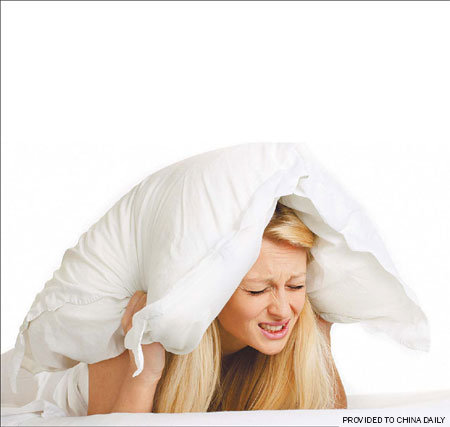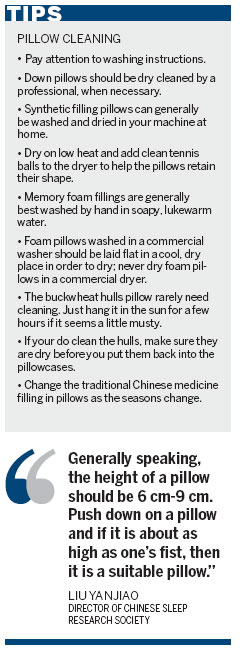Pillow talk


Pillow thickness, density, content, even traditional Chinese medicine filling can all determine how well you're sleeping. Liu Zhihua reports.
Qiu Shujun, a Beijing taxi driver, had been in agony after waking one morning in February. His neck was sore and turning his head was extremely painful. Qiu eventually realized the pain was caused by a new pillow his wife had bought him, which was thicker than his previous one.
When he changed back to the original pillow the neck pain vanished. He was surprised to learn that such a small difference could have such a big effect.
The thickness of pillows, their density and content, even what kind of traditional Chinese medicine (TCM) filling they have, all have a significant impact on the quality of sleep and how you feel during the day.
"A pillow is a necessity in life, but its importance can easily be made light of. People tend to reevaluate their casual choice of a pillow only when a wrong choice causes trouble sleeping," says Guo Xiheng, director of the sleep and breathing center at Beijing Chaoyang Hospital.
"A good pillow provides adequate support to the head when sleeping, so the neck does not have to support it."
The neck is a bridge between the head and the rest of the body. The cervical spine, or seven vertebrae in the neck, supports the skull and enables head movement. A complex system of ligaments, tendons and muscles helps to support the head and the backward "C" shaped cervical spine.
"The ideal pillow maintains the natural front to back curve of the cervical spine when sleeping, so the exertion of muscles and ligaments in the neck can be suspended," says Liu Yanjiao of the Guang'anmen Hospital, affiliated to Chinese Academy of Chinese Medical Sciences in Beijing, who is also a director of the Chinese Sleep Research Society.
"If the pillow destroys the balance of the natural curve, serious physical consequences may occur, such as a stiff neck and cerebral ischemia (insufficient blood flow to the brain)."
Thickness, or height of the pillow, is the most important factor to consider when choosing one and most experts say this should help keep the head and body in a horizontal line.
If the pillow is too high, the sleeper's head will bend forward and impose pressure on the artery in the neck and hinder blood supply to the brain, possibly causing snoring and a stiff neck.
When the pillow is low, too much blood will flow into the brain, blood pressure will increase and this can lead to dizziness and a puffy face the next day.
"Generally speaking, the height of a pillow should be 6 cm-9 cm. Push down on a pillow and if it is about as high as one's fist, then it is a suitable pillow," Liu says.
When sleeping on their sides, people may need a pillow that is a few centimeters higher, in order to keep the spine in alignment and feel comfortable, Liu adds.
Those who suffer from high blood pressure, cervical spondylosis (syndrome caused by degeneration of the cervical vertebrae) or crooked spine should not use thick pillows; while patients with pulmonary heart disease and asthma should not use thin pillows, he adds.
Equally, to guarantee a sound and healthy sleep, pillows should be neither too soft nor too hard.
Too hard and the contact area between the head and pillow is relatively very small, and as a result, the pressure of the head will be too much; too soft and the head will move around and the neck will grow weary.
"Although some people like soft pillows and others are fond of firm ones, a pillow should ideally be moderately soft to improve sleep," says Guo Xiheng with Beijing Chaoyang Hospital.
Another factor, Guo adds, is the pillow should not be damp, in which case the filling is critical. Filling varies from traditional buckwheat hulls to high technology memory foams and other dazzling man-made materials.
As for babies, Liu says those under 3 months need only a thin towel or handkerchief, and for older babies, pillows of 3 cm-4 cm or above, made of silkworm waste, or mung beans, are good choices.
Guo's preference is buckwheat hulls.
"It is easy to modify the shape of a pillow filled with buckwheat hulls. When you want to clean it, all you need to do is to take the hulls out, wash and dry in the sun," Guo says.
Yang Bing, a 24-year-old student at Peking University, has been using buckwheat hull pillows since he was a kid.
"I can form them into any shape I want, and the shape will last for a whole night," Yang says. "I don't believe in so-called high technology pillows. The natural ones are best."
For people who are allergic to buckwheat hulls, there are plenty of choices of "natural pillows", such as grain hulls, beans hulls and TCM stuffed pillows.
TCM stuffed pillows have different functions. For instance, a pillow filled with mulberry leaves and sweet wormwood herb is a wise choice in spring to reduce the activity of an overactive liver.
On hot days and nights, pillows with silkworm waste and chrysanthemum, which have cooling properties, are a better choice.
When autumn falls and dehydration becomes a problem (in Beijing), a mung bean stuffed pillow is an efficient solution. In winter, soft rush will calm the mind for a sound sleep.
Pillows with TCM fillings complement medical treatments for chronic diseases, under the direction of a doctor.
(China Daily 04/06/2011 page19)














